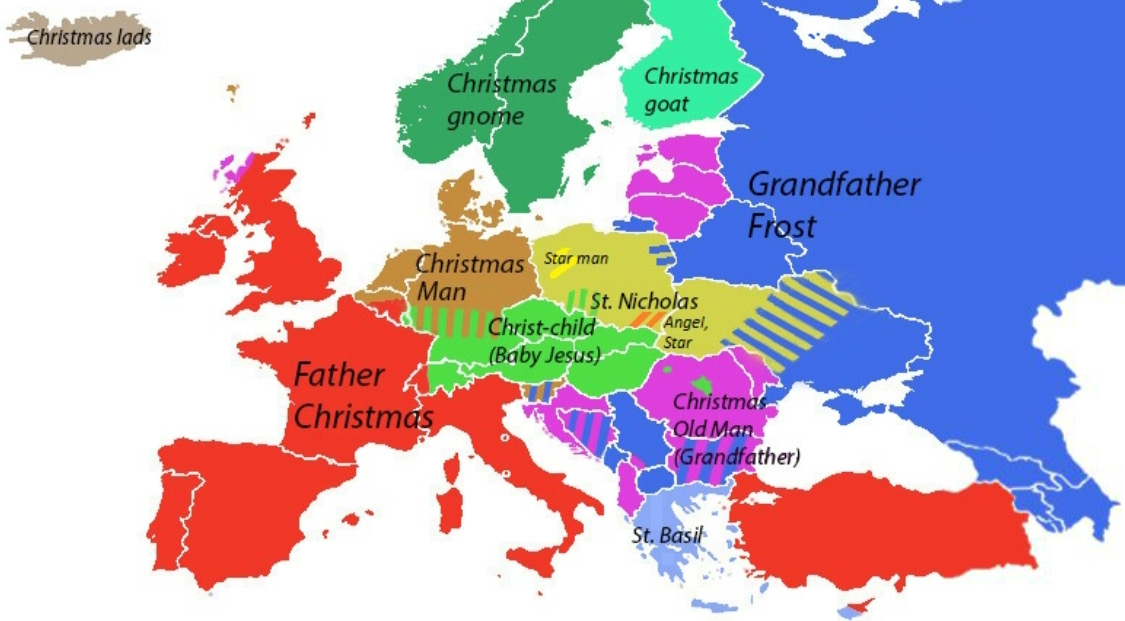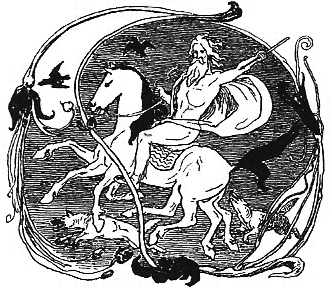|
Christmas Gift-bringer
A number of Midwinter or Christmas traditions in European folklore involve gift-bringers. Mostly involving the figure of a bearded old man, the traditions have mutually influenced one another, and have adopted aspects from Christian hagiography, even before the modern period. In Eastern Slavic countries, the figure is Father Frost. In Scandinavia, it is an elf-like figure or tomten who comes at Yule (and who sometimes also takes the form of a goat). In German-speaking Europe and Latin Europe, it became associated with the Christian Saint Nicholas. In some parts of Central Europe, there is a separate tradition of a young child or fairy-like being bringing presents, known as Christkind. Early modern England had Father Christmas, a character initially associated with feasting and good cheer, though he was not originally a gift bringer. From these European traditions, the North American figure of Santa Claus developed, beginning in the 1820s. The American figure in turn had consider ... [...More Info...] [...Related Items...] OR: [Wikipedia] [Google] [Baidu] |
Wodanaz
Odin (; from non, Óðinn, ) is a widely revered god in Germanic paganism. Norse mythology, the source of most surviving information about him, associates him with wisdom, healing, death, royalty, the gallows, knowledge, war, battle, victory, sorcery, poetry, frenzy, and the runic alphabet, and depicts him as the husband of the goddess Frigg. In wider Germanic mythology and paganism, the god was also known in Old English as ', in Old Saxon as , in Old Dutch as ''Wuodan'', in Old Frisian as ''Wêda'', and in Old High German as , all ultimately stemming from the Proto-Germanic theonym *''Wōðanaz'', meaning 'lord of frenzy', or 'leader of the possessed'. Odin appears as a prominent god throughout the recorded history of Northern Europe, from the Roman occupation of regions of Germania (from BCE) through movement of peoples during the Migration Period (4th to 6th centuries CE) and the Viking Age (8th to 11th centuries CE). In the modern period, the rural folklore of Germanic Eu ... [...More Info...] [...Related Items...] OR: [Wikipedia] [Google] [Baidu] |
Kobold
A kobold (occasionally cobold) is a mythical sprite. Having spread into Europe with various spellings including "goblin" and "hobgoblin", and later taking root and stemming from Germanic mythology, the concept survived into modern times in German folklore. Although usually invisible, a kobold can materialize in the form of a non-human animal, a fire, a human, and a candle. The most common depictions of kobolds show them as humanlike figures the size of small children. Kobolds who live in human homes wear the clothing of peasants; those who live in mines are hunched and ugly and some can materialise into a brick; kobolds who live on ships smoke pipes and wear sailor clothing. Legends tell of three major types of kobolds. Most commonly, the creatures are household spirits of ambivalent nature; while they sometimes perform domestic chores, they play malicious tricks if insulted or neglected. Famous kobolds of this type include King Goldemar, Heinzelmann, and Hödekin. In some re ... [...More Info...] [...Related Items...] OR: [Wikipedia] [Google] [Baidu] |
Household Spirit
A household deity is a deity or spirit that protects the home, looking after the entire household or certain key members. It has been a common belief in paganism as well as in folklore across many parts of the world. Household deities fit into two types; firstly, a specific deity typically a goddess often referred to as a hearth goddess or domestic goddess who is associated with the home and hearth, such as the ancient Greek Hestia. The second type of household deities are those that are not one singular deity, but a type, or species of animistic deity, who usually have lesser powers than major deities. This type was common in the religions of antiquity, such as the lares of ancient Roman religion, the gashin of Korean shamanism, and cofgodas of Anglo-Saxon paganism. These survived Christianisation as fairy-like creatures existing in folklore, such as the Anglo-Scottish brownie and Slavic domovoy. Household deities were usually worshipped not in temples but in the home, wher ... [...More Info...] [...Related Items...] OR: [Wikipedia] [Google] [Baidu] |
Austro-Bavarian
Bavarian (german: Bairisch , Bavarian: ''Boarisch'') or alternately Austro-Bavarian, is a West Germanic language, part of the Upper German family, together with Alemannic and East Franconian. Bavarian is spoken by approximately 12 million people in an area of around , making it the largest of all German dialects. It can be found in the German state of Bavaria (especially Old Bavaria), most of the Republic of Austria (excluding Vorarlberg) and the Italian region of South Tyrol.Rowley (2011), p. 300; In 2008, 45 percent of Bavarians claimed to use only dialect in everyday communication. Prior to 1945, Bavarian was also prevalent in parts of the southern Czech Republic and western Hungary. The difference between Bavarian and Standard High German is larger than the difference between Danish and Norwegian or between Czech and Slovak (Prof Dr. Robert Hinderling); as such, there is disagreement regarding its classification. The International Organization for Standardization classifie ... [...More Info...] [...Related Items...] OR: [Wikipedia] [Google] [Baidu] |
Krampus
Krampus is a horned, anthropomorphic figure in the Central and Eastern Alpine folklore Folklore is shared by a particular group of people; it encompasses the traditions common to that culture, subculture or group. This includes oral traditions such as tales, legends, proverbs and jokes. They include material culture, ranging ... of Europe who, during the Advent season, scares children who have misbehaved. Assisting Saint Nicholas (European folklore), Saint Nicholas, or Santa Claus, the pair visit children on the night of 6 December, with Saint Nicholas rewarding the well-behaved children with modest gifts such as oranges, dried fruit, walnuts and chocolate, while the badly behaved ones only receive punishment from Krampus with Birching, birch rods. Krampus day itself, on the other hand, is on the 5th of December. The origin of the figure is unclear; some Folklore studies, folklorists and anthropologists have postulated it as having pre-Christian origins. In traditio ... [...More Info...] [...Related Items...] OR: [Wikipedia] [Google] [Baidu] |
Companions Of Saint Nicholas
The companions of Saint Nicholas are a group of closely related figures who accompany Saint Nicholas throughout the territories formerly in the Holy Roman Empire or the countries that it influenced culturally. These characters act as a foil to the benevolent Christmas gift-bringer, threatening to thrash or abduct disobedient children. Jacob Grimm (''Deutsche Mythologie'') associated this character with the pre-Christian house spirit (kobold, elf) which could be benevolent or malicious, but whose mischievous side was emphasized after Christianization. The association of the Christmas gift-bringer with elves has parallels in English and Scandinavian folklore, and is ultimately and remotely connected to the Christmas elf in modern American folklore. Names for the "dark" or threatening companion figure include: ''Knecht Ruprecht'' in Germany, ''Krampus'' in Austria, Bavaria, Parkelj in Slovenia, Friuli, Croatia, Hungary (spelled ''Krampusz''); ''Klaubauf'' in Bavaria, Austria; ''Bar ... [...More Info...] [...Related Items...] OR: [Wikipedia] [Google] [Baidu] |
Deutsche Mythologie
''Deutsche Mythologie'' (, ''Teutonic Mythology'') is a treatise on Germanic mythology by Jacob Grimm. First published in Germany in 1835, the work is an exhaustive treatment of the subject, tracing the mythology and beliefs of the ancient Germanic peoples from their earliest attestations to their survivals in modern traditions, folktales and popular expressions. The structure of the ''Deutsche Mythologie'' is fairly encyclopaedic. The articles and chapters are discursive of philological, historical, folkloristic, and poetic aspects of the pre-Christian Germanic religions. The sources are varied epochally and geographically. In many instances, Grimm cites the North and West Germanic variants of a religious entity; thus the entry on Thor is titled 'Donar, Thunar (Thôrr)'. Older Germanic words, particularly those concerning ritual, are often compared to Latin equivalents, as evident in the table of contents. The English translation by Stallybrass (3 vols., with vol. 4, supplement) ... [...More Info...] [...Related Items...] OR: [Wikipedia] [Google] [Baidu] |
Jacob Grimm
Jacob Ludwig Karl Grimm (4 January 1785 – 20 September 1863), also known as Ludwig Karl, was a German author, linguist, philologist, jurist, and folklorist. He is known as the discoverer of Grimm's law of linguistics, the co-author of the monumental '' Deutsches Wörterbuch'', the author of ''Deutsche Mythologie'', and the editor of ''Grimms' Fairy Tales''. He was the older brother of Wilhelm Grimm; together, they were the literary duo known as the Brothers Grimm. Life and books Jacob Grimm was born 4 January 1785, in Hanau in Hesse-Kassel. His father, Philipp Grimm, was a lawyer who died while Jacob was a child, and his mother Dorothea was left with a very small income. Her sister was lady of the chamber to the Landgravine of Hesse, and she helped to support and educate the family. Jacob was sent to the public school at Kassel in 1798 with his younger brother Wilhelm. In 1802, he went to the University of Marburg where he studied law, a profession for which he had be ... [...More Info...] [...Related Items...] OR: [Wikipedia] [Google] [Baidu] |
Collier's Encyclopedia
''Collier's Encyclopedia'' is a discontinued general encyclopedia first published in 1949 by P. F. Collier and Son in the United States. With ''Encyclopedia Americana'' and ''Encyclopædia Britannica, Collier's Encyclopedia'' became one of the three major English-language general encyclopedias'':'' The three were sometimes collectively called "the ABCs". In 1998, Microsoft acquired the right to use ''Collier's Encyclopedia'' content from Atlas Editions, which had by then absorbed Collier Newfield. Microsoft incorporated ''Collier's Encyclopedia'''s content into its ''Encarta'' digital multimedia encyclopedia, which it marketed until 2009. ''Collier's Encyclopedia'' was an entirely new, 20 volume work, with the first volumes available in 1949 and all volumes published by 1951. It had more than 2,000 contributors, included 10,000 black and white illustrations, 96 pages of four-color illustrations, 126 colored maps and 100 black and white line maps. There were more than 400,000 inde ... [...More Info...] [...Related Items...] OR: [Wikipedia] [Google] [Baidu] |
Norse Mythology
Norse, Nordic, or Scandinavian mythology is the body of myths belonging to the North Germanic peoples, stemming from Old Norse religion and continuing after the Christianization of Scandinavia, and into the Nordic folklore of the modern period. The northernmost extension of Germanic mythology and stemming from Proto-Germanic folklore, Norse mythology consists of tales of various deities, beings, and heroes derived from numerous sources from both before and after the pagan period, including medieval manuscripts, archaeological representations, and folk tradition. The source texts mention numerous gods such as the thunder-god Thor, the raven-flanked god Odin, the goddess Freyja, and numerous other deities. Most of the surviving mythology centers on the plights of the gods and their interaction with several other beings, such as humanity and the jötnar, beings who may be friends, lovers, foes, or family members of the gods. The cosmos in Norse mythology consists of Nine Worl ... [...More Info...] [...Related Items...] OR: [Wikipedia] [Google] [Baidu] |
Sleipnir
In Norse mythology, Sleipnir (Old Norse: ; "slippy"Orchard (1997:151). or "the slipper"Kermode (1904:6).) is an eight-legged horse ridden by Odin. Sleipnir is attested in the ''Poetic Edda'', compiled in the 13th century from earlier traditional sources, and the ''Prose Edda'', written in the 13th century by Snorri Sturluson. In both sources, Sleipnir is Odin's steed, is the child of Loki and Svaðilfari, is described as the best of all horses, and is sometimes ridden to the location of Hel (location), Hel. The ''Prose Edda'' contains extended information regarding the circumstances of Sleipnir's birth, and details that he is grey in color. Sleipnir is also mentioned in a riddle found in the 13th century legendary saga ''Hervarar saga ok Heiðreks'', in the 13th-century legendary saga ''Völsunga saga'' as the ancestor of the horse Grani, and book I of ''Gesta Danorum'', written in the 12th century by Saxo Grammaticus, contains an episode considered by many scholars to involve Sl ... [...More Info...] [...Related Items...] OR: [Wikipedia] [Google] [Baidu] |


.jpg)



.jpg)


